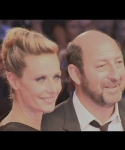var js, id = ‘facebook-jssdk’; if (d.getElementById(id)) {return;}
js = d.createElement(‘script’); js.id = id; js.async = true;
js.src = “//connect.facebook.net/en_US/all.js#xfbml=1″;
d.getElementsByTagName(‘head’)[0].appendChild(js);
}(document));
After attending this year’s Berlin International Film Festival I thought I should take the time to review one of the only films that really stood out for me (unfortunately I only got to see six), that being the wonderfully original Japanese gender-switcher from newcomer Kimura Shoko. I was lucky enough to attend the screening that Shoko herself attended and so got to witness the very interesting Q&A that followed the film. In this article I will review the film and follow it with my analysis and some of what I noted from the Q&A. Please enjoy and do leave any comments you have below. If you’ve seen the film, I’d love to know what you thought of it!
Sometimes feeling more like an anime than a live action film, with its overly exaggerated, high energy, kooky character performances and 8bit music score; The End of Puberty opens with obsessed schoolgirl Tsubara (Wagatsuma Miwako) fawning over her nerdy, flustered teacher Mr. Madoka (Saito Yoichiro) as he struggles to hold his lesson together. As the rest of the classes’ attentions wander, Tsubara is seen feverishly scribbling something into a notebook which turns out to be an extensive list of the daily idiosyncrasies that Madoko displays each class as his frustration and panic rises as a result of his powerlessness. The rest of the notebook is devoted to many drawings depicting the fusing together of Tsubara and Madoko via their genitals, finishing with a complete swap…
If this isn’t strange enough, Tsubara’s perverse dream comes true when she literally pounces of Madoko one day after class and following a confused sexual tumble the magic is complete much to Madoko’s horror and to Tsubara’s delight. The two escape to the countryside to hide while they decide what to do, Madoka now bursting into fits of wretching at even the slightest touch from Tsubara. No sooner that they have retreated to Madoko’s secluded childhood home that are they followed by En (Satsukawa Aimi), the enigmatic best friend of Tsubara who is secretly in love with her and then by Maru (Sometani Shota), the puppy dog-like admirer of En completing a crazy love circle. What ensues is a story not just about the trials and sexual confusion of adolescence but also a fresh and unique take on the body-swap genre which causes us to question the importance of gender altogether. Should we allow our genders define who we are?
What made this film so enjoyable for me was its distinctly Japanese feel. Only in Japan would you find such a bizarrely premised film with a cast of caricature-like characters, so exaggerated they are; while also managing to convey a deeper meaning, raising questions that are fundamental the society we live in.
| Kimura Shoko at the Berlinale screening of the film |
Other interesting points that were raised were the subjects of name and costume. All of the characters’ names; Tsubara, Madoko, En and Maru are apparently written with the same Japanese characters which Shoko intended to denote a sense of unity or circle. Likewise each of the characters’ costumes hold significance. Tsubara is always seen wearing bright reds to emphasise her energy. En always wears greys and blues to emphasise her boredom with life. Maru wears bright greens and pink to show his energy like Tsubara, while Madoko frequently wears beige, white and black to emphasise how boring and unadventurous he is.
However contrasting our ideas, with this astounding first feature I feel the young Kimura Shoko (only 25!) will be one to watch in the future!
![Freestyle SB.TV Warm Up Sessions – Blizzard [Grime] – [S3.EP13]](http://mp3forfree.ueuo.com/wordpress/wp-content/themes/silverorchid-music/timthumb.php?src=http://i.ytimg.com/vi/ADmeh_ZTHAg/0.jpg&w=150&h=150&zc=1&q=100)





























